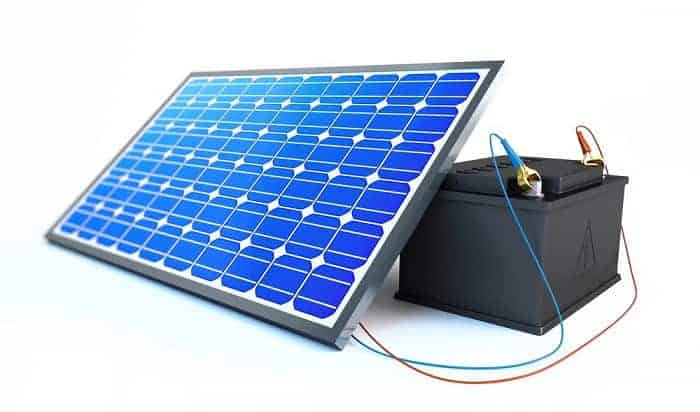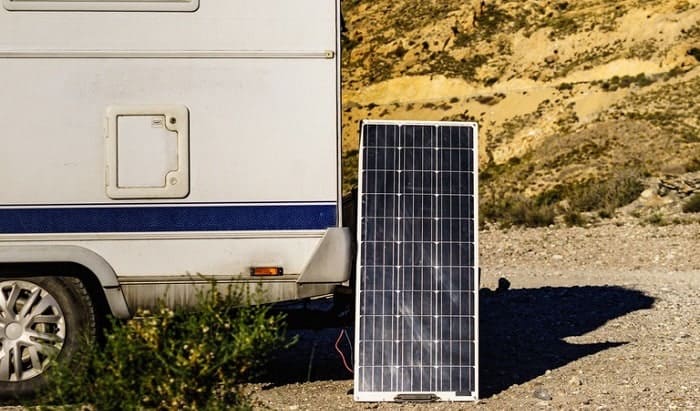There’s no denying that charging a battery with a solar panel is an excellent alternative, especially when you have decided to utilize renewable energy sources. However, you’ve got to learn how to get started. One of the things you’ll need to explore is how long to charge 12V battery with 100 Watt solar panel.
Let’s go through the additional information about charging your 12-volt battery with a 100-watt solar panel below.
Table of Contents
- How Long to Charge 12V Battery with 100 Watt Solar Panel
- Is the Kind of Battery I Use a Crucial Factor to Consider
- What Solar Panel Size Do I Need to Use to Charge a 12Volt Battery
- The Valuable Role of a Solar Charge Regulator
- What Type of Charge Regulator is Best to Use, a PWM or an MPPT?
- How Much Power Can a 100W Solar Panel Produce
- Charging Batteries with Solar Panels
- Conclusion
How Long to Charge 12V Battery with 100 Watt Solar Panel
If you’re planning to charge a 12-volt battery with a 100-watt solar panel, for sure, you’ll get to enjoy making the most out of free energy. The delightful news is that charging your 12-volt battery with a 100-watt solar panel is not a burdensome and time-consuming process.
If you’re wondering how long does a 100 watt solar panel charge a battery, the answer to that will largely depend on the battery’s size. On average, it could vary between five to eight hours.
Hence, we can safely assert that a 100W solar panel that could produce 1 amp of current will take approximately five to eight hours to charge a 12-volt battery fully.
Nonetheless, you’ve got to ensure that your solar panel system directly faces the sun and no barriers in between to obtain more efficient and effective charging. Indeed, charging time varies depending on the amp output as well as the size of the solar panel system.
That said, keep in mind that a large panel could charge a vehicle’s battery much quicker than a solar charger designed with a smaller panel.
Is the Kind of Battery I Use a Crucial Factor to Consider
The answer to this question is yes! Bear in mind that different forms of batteries could significantly impact how your solar installation works. Generally speaking, there are different forms of deep cycle batteries utilized in solar systems, including lithium iron phosphate, sealed lead acid, and flooded lead-acid batteries.
Substantially, each of these batteries comes in different battery capacities, price ranges, cycle lives, as well as voltage. For instance, the capacity of a battery is essential since it gauges the amount of power you can keep. Hence, if you need to run specific home appliances for an extended time, you’ll require batteries designed with more oversized loads.
Battery capacity is gauged in total amp-hours. Consider checking the battery life cycle to delve into the charge cycles and the number of discharges it could provide before it falls below the rated capacity.
What Solar Panel Size Do I Need to Use to Charge a 12Volt Battery
In general, a solar vehicle battery charger could generate 13.6 Volt to 17.0 Volt, depending on the type of model you pick. These versions are manufactured to charge standard vehicle batteries, and they could also run any 12V gadgets.
For compact and lightweight off-grid systems, such solar chargers are ideal because they could be utilized for cars, boats, small cabins, and recreational vehicles. When it comes to size, a regular solar panel measures 65×39 inches; this one is utilized to charge a 12Volt 100W battery.
Meanwhile, if you’re looking for solar panels you’ll use for commercial applications, the standard size is 77×39-inches.
The Valuable Role of a Solar Charge Regulator
When you charge 12V battery with solar panel, it’s necessary to install a charge controller. This tool would monitor the voltage from the solar panel before it’s transmitted to the battery. Such an approach is fundamental because, on sunny days, the solar panel might produce more energy than needed, impairing the battery.
You’ll need to use a solar charge regulator when utilizing a 100W solar panel to load your 12V battery because it prevents the risk of battery overcharging and damage.
What Type of Charge Regulator is Best to Use, a PWM or an MPPT?
The significant difference between MPPT and PWM systems is that the former is 30 percent more efficient. With MPPT systems, you can enjoy more flexibility in system growth since the panel series can have a higher voltage than batteries.
If the location where you reside lacks irradiance or is more susceptible to intermittent cloud cover, an MPPT model might be a great option.
So, how do MPPTs work? It’s worth noting that all solar panel systems come with a “characteristic resistance”, which is usually approximately three ohms for a hundred-watt solar panel system.
An MPPT controller regulates its inherent resistance to fit the solar panels to optimize the current production of the solar panels and quickly charge the batteries.
Regardless, since MPPT controllers are costlier than PWM versions, some people still use PWM controllers in small systems, specifically if efficiency is not crucial. Take note that the solar energy system’s size is critical in selecting charge control devices.
PWM charge controllers are ideal for offering adequate performance for low-power applications. On the other hand, MPPT charge regulators are highly recommended for professional applications.
Essentially, the efficiency difference between MPPTs and PWMs might not be enough to validate the price difference in small applications. But in significantly big applications, it certainly plays a vital role with regards to how excellent the system performs.
You might also want to check out this video explaining how to set up a primary solar charge controller:
How Much Power Can a 100W Solar Panel Produce
The amount of power a 100W solar panel can produce will primarily rely on the amount of sunlight it absorbs. Hence, if your current location acquires an average of almost five hours of direct sunlight, a 100W solar panel can generate about 500W of power in a day.
A 500W power is good enough for running a 50W laptop for roughly ten hours and a 15W compact fluorescent lamp for more than 30 hours. It can also power a 100W 42-inch LED television.
Charging Batteries with Solar Panels
Solar batteries serve a very prominent role in storing the energy that’s accumulated by the solar panels. The higher the capacity of your battery, the more solar energy it could store. You’ll require an inverter, solar charge regulator, and solar panels if you’d like to utilize batteries as a component of your solar setup.
When utilizing batteries for solar panels as a component of your home solar system, you can save the excess energy your solar panels generate rather than transmitting that energy back into the grid.
In the same way, electricity will be transmitted to the grid if the batteries are ultimately charged and the solar panels are still generating energy. Remember that your solar panels will require linking to a charge regulator that would help regulate the amount of energy kept in the batteries.
This method will significantly help avert overcharging. What’s more, charge regulators will automatically stop the system if the batteries become too drained.
You’ll need to connect the batteries to an inverter to transform the DC energy accumulated from panels to AC energy. This process must be done before powering your home appliances.
The Quick and Simple Process of Charging a Battery with Solar Panel
- Link the cable of the battery to your solar charge regulator.
- Carefully inspect the solar charge regulator to see if it’s working correctly.
- Lastly, link the 100W solar panel to your solar charge regulator.
Heads Up
See to it that your solar panels are positioned somewhere where there is no obstruction to direct sunlight. This is for them to generate the optimal-rated power. Conditions such as shadows, short winter days, incorrect mounting angle, and the cloudy sky will minimize the actual solar panel output below the graded values.
If you diligently follow the aforementioned easy-to-follow tips, you can quickly charge your 12V battery with a 100W solar panel.
Conclusion
In a nutshell, charging 12V batteries with solar panels is a no-sweat process if you take into account the important factors when doing the task. Again, before you start charging your 12V batteries with 100W solar panels, you need to consider the following:
- Where is your current location?
- What’s the fully charged battery capacity?
- What type of solar regulator will you be using?
Did we answer your question about how long to charge 12V battery with 100 watt solar panel? Hopefully, the information we have discussed in this article can help you enjoy the best possible perks of using renewable energy sources. Being well-informed about going solar can undoubtedly help you enjoy using clean and green energy.

I am Kathleen Miller, staff writer and reviewer of the Avasolar team. Working with the team has been a pleasure for me so far, I hope to bring readers useful information by creating detailed and easy-to-follow contents.



